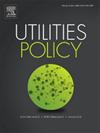考察巴基斯坦双城采用太阳能光伏的挑战和驱动因素
IF 4.4
3区 经济学
Q3 ENERGY & FUELS
引用次数: 0
摘要
在经历了几十年的电力短缺之后,巴基斯坦家庭必须转向可再生能源,以实现经济和环境的可持续性。由于87%的家庭无法获得清洁电力,太阳能光伏(PV)系统提供了一个可行的选择。除了提供能源安全,太阳能光伏技术还通过减少对化石燃料的依赖来缓解气候变化。虽然光伏系统已在许多国家成功采用,但由于成本限制,巴基斯坦国内的太阳能潜力在很大程度上仍未开发。本研究考察了巴基斯坦双城家庭中太阳能光伏系统的采用情况,考虑了社会经济和人口因素。尽管太阳能光伏发电技术比传统发电技术有优势,但有几个障碍阻碍了其广泛采用,其中成本成为主要障碍。缺乏足够的政府支持也阻碍了这项技术的普及。其他挑战包括家庭收入低、房屋位置和房屋所有权状况。然而,环境问题和太阳能设备在当地市场的可用性鼓励一些家庭投资太阳能光伏系统。采用三阶段随机抽样方法,选取了501个双城家庭。只有25%的家庭拥有太阳能光伏(PV)系统,尽管77%的家庭在停电时使用备用电源。根据双重障碍(DH)回归模型,受教育程度越高的家庭更有可能安装太阳能光伏系统。房屋所有权和同伴影响也提高了采用率。由于前期支出的费用和不合适的居住地点(如公寓),许多家庭避免转换。家庭太阳能系统的税收优惠和补贴可以促进采用,帮助稳定电力供应,缓解气候变化。本文章由计算机程序翻译,如有差异,请以英文原文为准。
Examining the challenges and drivers of solar photovoltaic adoption in the twin cities of Pakistan
After decades of electricity shortages, Pakistani households must transition to renewable energy for economic and environmental sustainability. With 87 % of homes lacking access to clean electricity, solar photovoltaic (PV) systems present a viable alternative. Beyond providing energy security, solar PV technology mitigates climate change by reducing reliance on fossil fuels. While PV systems have been successfully adopted in many countries, Pakistan's domestic solar potential remains largely untapped due to cost constraints. This study examines the adoption of solar PV systems among households in Pakistan's twin cities, considering socioeconomic and demographic factors. Although solar PV technology offers advantages over traditional power generation, several obstacles have hindered widespread adoption, with cost emerging as the primary barrier. The lack of sufficient government support has also slowed adoption. Other challenges include low household income, location of the house, and homeownership status. However, environmental concerns and the availability of solar equipment in local markets have encouraged some households to invest in solar PV systems. A three-stage random sample approach was used to select 501 twin-city families. Only 25 % of households have solar photovoltaic (PV) systems, despite 77 % using electrical backups during power outages. According to the Double Hurdle (DH) regression model, households with more educated heads are more likely to install solar PV systems. Homeownership and peer influence also boost adoption rates. Many households avoid switching due to the expense of upfront expenditures and unsuitable dwelling locations, such as apartments. Tax incentives and subsidies for home solar systems could boost adoption, help stabilize power supply, and mitigate climate change.
求助全文
通过发布文献求助,成功后即可免费获取论文全文。
去求助
来源期刊

Utilities Policy
ENERGY & FUELS-ENVIRONMENTAL SCIENCES
CiteScore
6.80
自引率
10.00%
发文量
94
审稿时长
66 days
期刊介绍:
Utilities Policy is deliberately international, interdisciplinary, and intersectoral. Articles address utility trends and issues in both developed and developing economies. Authors and reviewers come from various disciplines, including economics, political science, sociology, law, finance, accounting, management, and engineering. Areas of focus include the utility and network industries providing essential electricity, natural gas, water and wastewater, solid waste, communications, broadband, postal, and public transportation services.
Utilities Policy invites submissions that apply various quantitative and qualitative methods. Contributions are welcome from both established and emerging scholars as well as accomplished practitioners. Interdisciplinary, comparative, and applied works are encouraged. Submissions to the journal should have a clear focus on governance, performance, and/or analysis of public utilities with an aim toward informing the policymaking process and providing recommendations as appropriate. Relevant topics and issues include but are not limited to industry structures and ownership, market design and dynamics, economic development, resource planning, system modeling, accounting and finance, infrastructure investment, supply and demand efficiency, strategic management and productivity, network operations and integration, supply chains, adaptation and flexibility, service-quality standards, benchmarking and metrics, benefit-cost analysis, behavior and incentives, pricing and demand response, economic and environmental regulation, regulatory performance and impact, restructuring and deregulation, and policy institutions.
 求助内容:
求助内容: 应助结果提醒方式:
应助结果提醒方式:


